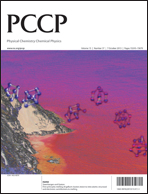Electronic and molecular behaviors of a novel ionic paramagnetic ruthenium(iii) complex†
Abstract
The geometric structures, electronic and molecular properties of the novel ionic paramagnetic ruthenium(III) complex—bis[1-butyl-2-(diphenylphosphanyl)-3-methylimidazolium]tetrachloridoruthenium(III) hexafluorophosphate, which was synthesized experimentally very recently, are investigated by means of first-principles calculations. The molecular structures consistent with the experiment were obtained by optimized calculations. The detailed analysis of the chemical bonding in the ruthenium(III) complex indicates that the interactions of Ru–Cl and Ru–P are dominated by an ionic interaction, while the P–C bonding is of mainly covalent interaction. Our results also show that the ruthenium(III) complex is of magnetic character with a magnetic moment of 1 μb contributed by the central metal atom—Ru. In addition, identifying the orbital compositions in the frontier electronic structures, we proposed that the high catalytic performance of the Ruthenium(III) complex mainly arises from the strong interaction of the frontier orbitals between the reactants and the


 Please wait while we load your content...
Please wait while we load your content...